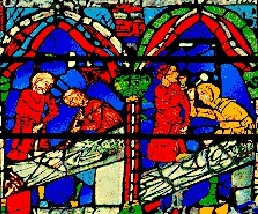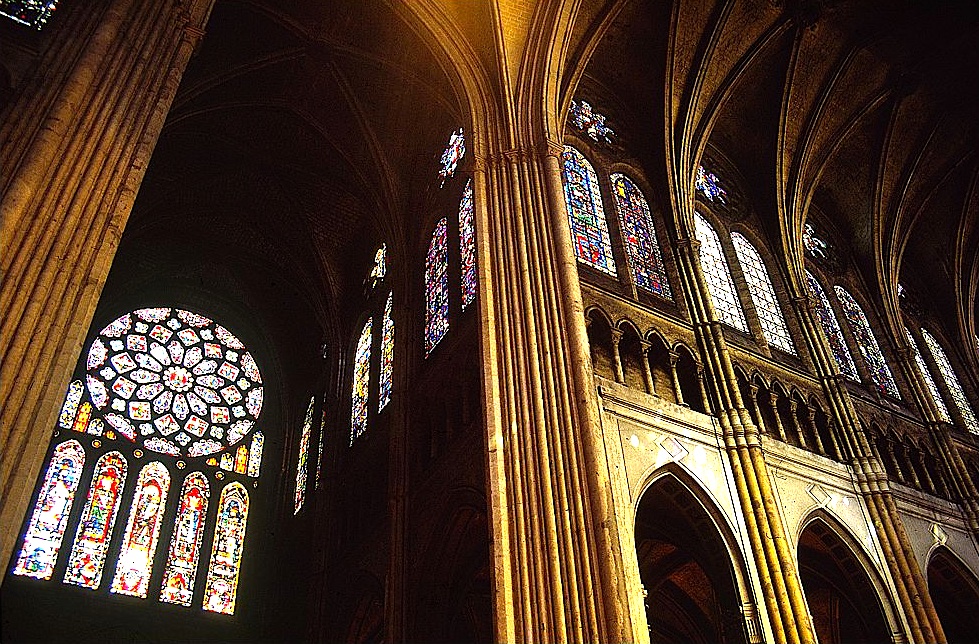
|
St. Nicolas Window
The windows at Chartres represent a panorama of medieval society from royalty, to merchants, trades people and craftsmen. The contributors of one hundred and sixteen windows have been identified.
The donors of the St. Nicolas window were merchants of dry goods, spices and medicinal drugs. The image illustrates local business as well as the existence of an import trade. Because many of these pharmaceuticals were not native to France, they were brought from other parts of Europe and the Near East. These merchants also sold their wears during important church festivals.
|

|
St. Lubin Window 1210
St. Lubin, the Bishop of Chartres in 558 who performed miracles and was the patron saint of the local inn-keepers and wine merchants who were the donors of the window.
Wine as a staple of the diet was consumed by both local residents and the pilgrim trade and therefore was important to the economy. Both wine and bread were used as payments for church tithes and the king's taxes. As a land owner, the church was also in the wine business. The bishop owned some of the finest vineyards in the region and his consecrated wine was used by the church. At times the wine merchants were so powerful that they were able advertise in the nave. Wine was sold near the nave of the cathedral until 1327, when it was restricted to the crypt (Swaan p.31).
The scene depicts a wine merchant offering a goblet to a customer seated before him. Behind him is a wine crier announcing the tapping of a new barrel of wine. He is shown physically smaller because of his lower social standing. The barrel-hoop was a sign for a tavern and the tower on the right advertises its location in the town. Because the image was adapted from a traditional communion scene it could be interpreted as a tavern keeper providing refreshment for a traveler just as the church offers salvation for his soul.
|

|
Joseph window 1210
The donors of the window of Joseph the Patriarch belonged to the money-changers guild. The depiction of this group weighing gold would appear to be at odds with the gospel story of Christ driving the money-changers from the temple. However, Chartres was a worldly church, and the guild not only paid a high tithe but was also essential to the economy and the stability of coinage.
The money-changers appear in the windows of saints who symbolize the office of the bishop. Joseph represented an Old Testament prototype for the bishop's temporal authority. In the Genesis narrative Joseph was made governor of Egypt after successfully interpreting the Pharaoh繒s dreams. He saved the tribes of Israel from a great famine by giving them grain from the Pharaoh's storehouses. The money-changer's gold was likened to the Joseph's golden grain, suggesting that the bishop had some control over the exchange and distribution of their wealth (William, p. 133).
|

|
Redemption Window
Donors were usually depicted in one of the bottom panes where they could be seen. This image, representing the important blacksmith guild. It is a visual description of the medieval methods of shoeing a horse. The horse is shown in a wooden frame being held firmly by bridle and hind leg. These scenes of ordinary people working are valuable to historians for their documentation of equipment and trade practices.
|
|

|
St. Cheron: Masons
|

|
St. Cheron: Sculptors
|
Source: 
 Transept of Chartres Cathedral
Transept of Chartres Cathedral





